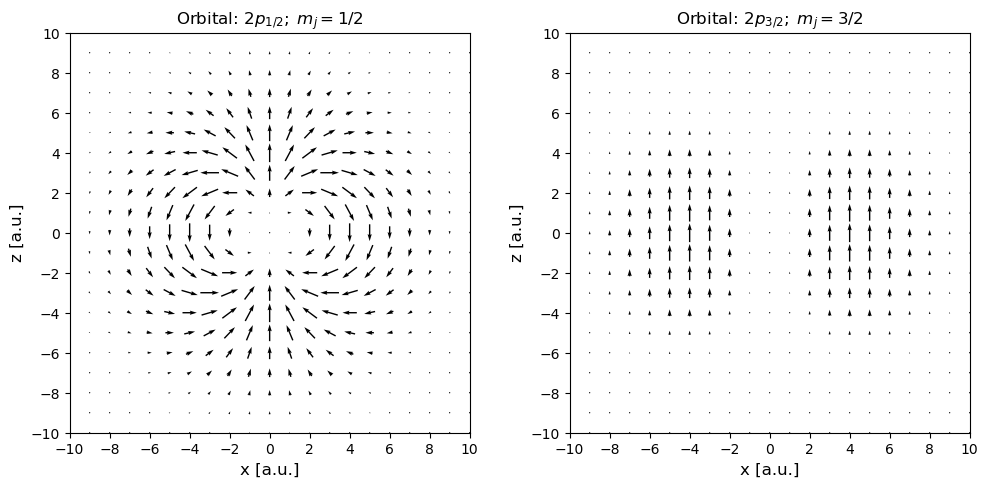Electron spin#
Electrons have an internal angular momentum referred to as spin and which interacts with external as well as internal magnetic fields in molecular systems, where the latter originate from other charged particles (electrons and nuclei) in relative motion. The spatial distribution of the electron spin will accommodate itself to these magnetic fields and in general be inhomogeneous.
Single-electron systems#
When speaking about the spin of an electron at position \(\mathbf{r}\) in space, we refer to expectation values of spin operators for electronic wave functions at the said position. The three canonical spin operators for a one-electron system are written in terms of the Pauli matrices
with a cyclic commutation relation written in terms of the Levi-Civita symbol
Other derived spin operators include the total spin operator
and the ladder operators
As an example, due to spin–orbit interactions the \(2p_{1/2}\) and \(2p_{3/2}\) levels in the hydrogen atom show a fine-structure splitting. Let us study the wave functions associated with the \(m_j = 1/2\) and \(m_j = 3/2\) components of these respective levels that are given by
with the spinor spherical harmonics expressed in the regular spherical harmonics as
The components of the spin density are equal to
We plot this vector field in the \(xz\)-plane where \(\phi = 0\) (overall normalization factors are left out).
import matplotlib.pyplot as plt
import numpy as np
n = 21
m = 11
x = np.linspace(-10, 10, n)
z = np.linspace(-10, 10, n)
(X, Z) = np.meshgrid(x, z)
theta = np.zeros((n, n))
theta[m:, m:] = np.arctan(X[m:, m:] / Z[m:, m:])
theta[m:, : m - 1] = np.arctan(X[m:, : m - 1] / Z[m:, : m - 1])
theta[: m - 1, : m - 1] = np.arctan(X[: m - 1, : m - 1] / Z[: m - 1, : m - 1]) - np.pi
theta[: m - 1, m:] = np.arctan(X[: m - 1, m:] / Z[: m - 1, m:]) + np.pi
theta[m - 1, m:] = np.pi / 2
theta[m - 1, : m - 1] = -np.pi / 2
# rho = r**2 * |R_{2,1}|**2
r = np.sqrt(X**2 + Z**2)
rho = r**4 * np.exp(-r)
u = np.sin(2 * theta) * rho
v = np.cos(2 * theta) * rho
fig1 = plt.figure(1, figsize=(10, 5))
h1 = plt.axes([0.1, 0.1, 0.4, 0.8], frame_on=True)
plt.quiver(x, z, u, v, color="k", units="xy", pivot="mid", scale=5, width=0.07)
plt.xlabel("x [a.u.]", size=12)
plt.ylabel("z [a.u.]", size=12)
plt.setp(
h1,
xlim=(-9.5, 9.5),
ylim=(-9.5, 9.5),
xticks=range(-10, 11, 2),
yticks=range(-10, 11, 2),
)
plt.title(r"Orbital: $2p_{1/2};\; m_j=1/2$", color="k", size=12)
u = 0.0 * rho
v = np.sin(theta) ** 2 * rho
h2 = plt.axes([0.6, 0.1, 0.4, 0.8], frame_on=True)
q2 = plt.quiver(x, z, u, v, color="k", units="xy", pivot="mid", scale=5, width=0.07)
plt.xlabel("x [a.u.]", size=12)
plt.ylabel("z [a.u.]", size=12)
plt.setp(
h2,
xlim=(-9.5, 9.5),
ylim=(-9.5, 9.5),
xticks=range(-10, 11, 2),
yticks=range(-10, 11, 2),
)
plt.title(r"Orbital: $2p_{3/2};\; m_j=3/2$", color="k", size=12)
plt.show()

It is clearly seen that the spin in the upper \(2p_{3/2}\) level is collinear whereas it is more complex and noncollinear in the lower \(2p_{1/2}\) level.
Many-electron systems#
For a many-electron system, the Cartesian spin operators take the form
with ladder operators
and the total spin operator is a two-electron operator equal to
The commutator relation takes the same form as in the one-electron case
which enables us to derive the alternative expressions for the total spin operator
When the Hamiltonian is spin-independent, there exist common eigenstates to the set of commuting operators \(\hat{H}\), \(\hat{S}^2\), and \(\hat{S}_z\):
States with \(S = 0, \frac{1}{2}, 1\) are referred to as singlets, doublets, and triplets, respectively, associated with energy degeneracy with respect to the \(M_S\) quantum number. While we in practice are unable to find the exact eigenstates of the Hamiltonian, it is straightforward to form spin-adapted linear combinations of Slater determinants that are exact eigenstates of the spin operators.
Spin and Slater determinants#
All determinants#
All Slater determinants are eigenfunctions of \(\hat{S}_z\) and the associated quantum number is equal to
where \(N^\alpha\) and \(N^\beta\) refer to the number of occupied \(\alpha\)- and \(\beta\)-spin orbitals. In particular, all closed-shell states have zero projection of the spin angular momentum along the \(z\)-axis.
High-spin determinants#
All high-spin determinants are eigenfunctions of both \(\hat{S}_z\) and \(\hat{S}^2\). The quantum number associated with the total spin operators is in this case equal to
HOMO–LUMO excited determinants#
For a system described by a closed-shell state, an electron excitation from the highest occupied (HOMO) to the lowest unoccupied molecular orbital (LUMO) can result in a final state of singlet or triplet spin symmetry.
The spin-adapted wave function representing the singlet state is given by
The spin-adapted wave functions representing the three components of the triplet state are given by
In this frozen-orbital approximation, the energy separation between the lowest excited singlet and triplet states equals twice the exchange energy between the HOMO and LUMO orbitals
